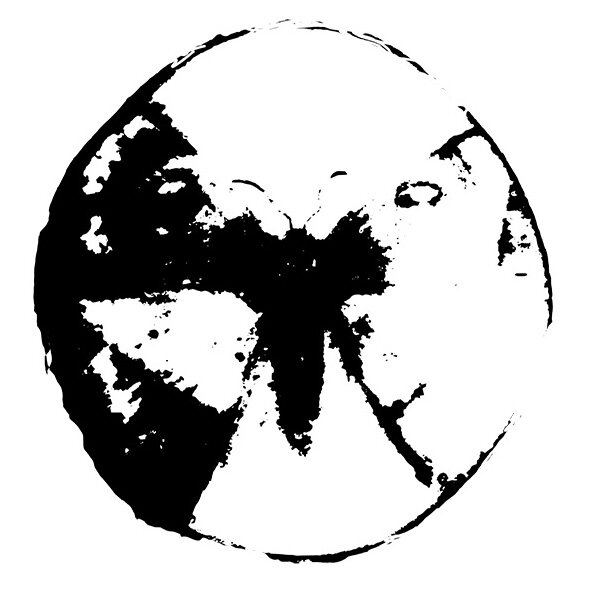I felt completely seen and understood when I saw her. The light fell dimly in the room where she was bent down on her knees, her thighs and calves supporting her torso and upper-body. Her legs seemed solid and strong, carrying her weight as she kneeled on what looked like a cold tile floor. Her body was turned to the side. From my perspective I could see every detail clearly: how her muscles and joints were pressing slightly against her skin. The intricate nature of her hands and feet were drawn with clarity and precision, the soft charcoal coaxing the firm roundness of flesh into existence. She was moving, her head coming down to the baseline of the image, moving her weight onto her haunches, then back to the floor again. She was completely bare, hovering over something unseen. The artist had drawn herself with part of her skeleton exposed, her skull rising above, yet still part of her. The movement of her mark-making, the gesture of her trained scribble, was used to create unity between her body and her bones. The movement of that scribble was like wind through a willow tree, or how sand must feel being sifted and pulled from the shore to open water.
This drawing was a departure from the images of women I was used to seeing. Airbrushed and Photoshopped, wearing peach colored lip gloss. Women with impossibly arched backs pushing themselves into a pose, morphing into poster children for a Coke and a smile. Or in the pornography I found hidden inside my brother’s nightstand. These images were glossy and contrived. I became spellbound by their celluloid nature, but also eerily repelled by them in equal measure. I felt the weight of an ideal that was absurd, impossible to achieve. This portrait was, by contrast, honest. It contained texture and dimension. Beauty informed by design and ineffable grit. Its splendid composition carried a story of what it felt like to live in a female body--and the contradiction and cultural weight that came along with it.
As I stood in front of the portrait, I remembered the first time I felt the need to cover my body. I was eight years old. My grandmother (who often took me to church in the hot summer months) began to take a keen interest in my wardrobe. The length of my skirt or the amount of my shoulder exposed were of particular interest. She would say nothing. It was more her squinted-eye and furrowed-brow that told me she disapproved. When I asked, “Why?” I remember silence. This silence triggered an enormous amount of shame. That shame followed me into my years as a young adult. It had followed me to that a day as a beginning art student.
In traditional life drawing, the instruction is done with a model that is completely unclothed. Our class would be drawing that day from live models, but this course was offered from a Christian University that used a tight filter to sift its theology. As a result, the study of the nude figure was deemed inappropriate. As the model, dressed in her swimsuit, came into the room I picked up my porous charcoal. The medium scraped then softened, welling into the microscopic crevices of the paper. I drew her with a primordial longing to know my own original goodness.
Now, the classroom was empty, scattered with abandoned easels and discarded drawing paper. The portrait was hanging in the classroom, having been placed there as part of the university's permanent art collection. I stood next to it, gazing at my silent mentor. It seemed implausible that I could make a drawing with such honesty. But still, somewhere inside myself, I hoped it was possible. I knew that the artist who drew this image had started in this classroom. I saw the evidence of what she had made. I knew that if she could make this sort of work that it was possible for me. In my mind I drew an imaginary thread from the portrait into the center of my being. I held on to that thread like it was life itself.
When I was eight, I had taken the look my grandmother had given me and embraced it. The disdain, consciously held by her or not, became etched inside me. Her gaze like a hand drawn image, a portrait of what it meant to be a young girl. My childhood mind understood that I was loved only if I met certain expectations—and I came to believe I was innately flawed.
That day, in the light of the empty classroom next to the portrait, I started the process of drawing and living in a new way. I became aware of what Mary Oliver meant when she spoke of the “soft animal of your body.” Her words, calling me toward a reclaiming of a lost birthright. I began to understand the distortion and untruth of what I had internalized. I do not want to hand that message, the distortion, on to my daughter. So I continue the process of drawing something new. With the images that I make, but more importantly, with how I look into my daughter’s eyes. I want her to know that her body is miraculous, that every part of her is a gift. She a combination of dust, mind, and spirit. She is originally good. I honestly believe it is true.
In the pursuit of making art and living a life that makes sense to me, I find evidence of truth and beauty present in the world. There is a Living Presence that meets me through the process of artmaking. This Mystery is beyond my understanding. On my better days, I know myself to be completely seen and understood in this love. In my mind I draw an imaginary thread between myself and this Mystery. I hold on to that thread like life itself.
